A Scientific Look at Rogaine For Women Results
We review the results of scientific studies on rogain for women

This site is supported by affiliate advertising. Which means we may earn some money if you click the product links. Thanks for your support!
Rogaine for Women Results
Research on minoxidil started in the 1950s by the Upjohn Company. They were originally looking for an ulcer treatment but discovered the formula increased blood flow. The formula was finalized in 1963 with the intention to treat high blood pressure. Once Upjohn received FDA approval for human trials doctors conducting the trials discovered that minoxidil had an unanticipated side effect of increased hair growth.
These doctors (Guinter Kahn and Paul J. Grant) developed a topical application of minoxidil and began testing it. They determined minoxidil could indeed grow hair. This discovery was the start of minoxidil being recognized as a treatment for high blood pressure to a treatment for hair loss. However it was not be until 1988 that minoxidil would be marketed as Rogaine for hair loss. Then in 1992 Rogaine for women was released. Since that time what have we learned about Rogaine for women results?
Rogaine Studies
Over the past twenty plus years various studies have verified that Rogaine (aka minoxidil) does increase hair growth in women. As with most products results will vary by person. Lets take a look at a few of the studies on Rogaine for women results.
-
1987 Study of seventy two patients using two and three percent minoxidil treatment to promote hair growth. Seventy percent of the patients that continued to use minoxidil for thirty months had fifty percent more hair then at the start of the study. This was the original minoxidil study. This study was conducted on men.
-
2002 Study to review the effect of five percent topical minoxidil to that of two percent topical minoxidil. At the conclusion of the forty-eight week study patients using the five percent minoxidil formula were found to have forty-five percent more hair growth and experienced results faster than patients using the two percent formula. This study was conducted on men.
-
2004 Study to review the effect of five percent topical minoxidil to that of two percent topical minoxidil on three hundred-eighty-one patients. At the conclusion of the forty-eight week study researchers concluded the five percent minoxidil formula was effective at promoting increased hair growth. This study was conducted on women with female pattern hair loss.
-
2016 Study Study examining the results of minoxidil on women with Monilethrix. Monilethrix is a rare condition that results in short, dry, fragile hair that breaks off easily. Patients suffering with this condition often appear to have severely thin hair. In this study two women were treated with minoxidil. Both women responded well the treatment and see increased hair growth.
-
2017 Study to review the results of minoxidil on women with telogen effluvium which is characterized by severe hair loss or shedding. In this study thirty six women received an oral dose of minoxidil for six months. At the conclusion of the study researchers found that a daily dose of minoxidil resulted in reduced shedding.
How Rogaine Works
After reading these studies its pretty clear that Rogaine does help regrow hair in women and men. This may make you wonder just how does Rogaine work? Rogaine is considered a vasodilator. This means it increases blood flow. Beyond this its not exactly clear how Rogaine increases hair growth. Most experts believe that the increased blood flow enlarges hair follicles and prolongs the hair growth cycle. This ultimately leads to more hair. If your struggling through hairloss trying a small amount of Rogaine could be money well spent.
While Rogaine has been proven to help hair growth its not the final cure for hair loss. Rogaine will not help men or women who are completely bald. Its most effective when used at the first sign of hair loss. If there are similarities between your hair loss and what you read in the afore mentioned studies Rogaine might be worth a try.
Now checkout the head to head comparison of Viviscal vs Nutrafol

